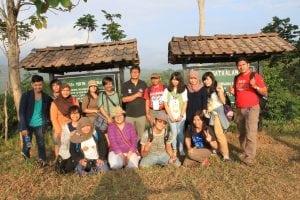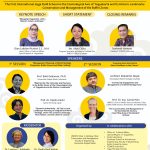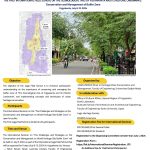For BFS 2013 participants were divided into four groups:
- Regional Group
- Architecture Group
- Temple Group
- Village Group.
Regional Group
The Regional Group investigated the changing landscape due to land conversion and the
following elements of heritage planning:
- building design
- historical landscape
- agricultural activity
- scenery and vista
- community initiatives
- support system
– support for saujana heritage planning (involving scenery and vista, building design,
historical landscape)
– support for sustainable agriculture (involving community initiatives and agricultural
activity).
Architecture Group
The Architecture Group made recommendations for:
- analysis
– impact effect from media, which considers that modern architecture is more
attractive
– the mind set of people that using modern shapes, materials, and structures will
increase their social status
– the variety of functions that impact tourism economic capacity and the capacity
of family members
– the lack of education about the traditional architecture of the house
– the addition of new functions and material (toilet, storage, additional rooms)
based on needs
– the lack of time for maintenance, so materials are changed for ease of maintenance
(ceramics, bricks, etc.)
– new materials are cheaper than local materials
- strategy
– provide education for the people to understand, and be proud to live in, the
heritage area
– acknowledge buildings that have good traditional architecture
– acknowledge people who have good traditional houses
– provide a map to guide local people and tourists (‘learning by seeing’)
– provide documentation (surveys, measurements, drawings, etc. for publication),
especially for local people
- guidelines
– if architectural materials need to be changed, the frst priority should be to use
local materials
– retain the pattern of the building envelope, shape, and structure (proportion,
confguration)
– additional components must be similar and in harmony with traditional
components.
Temple Group
The Temple Group looked at community involvement in tourism activity in the Pawon Temple
area and considered:
- problems
– tourists come to Pawon Temple for a few minutes only to see the temple, not villages around the temple
– lack of information about Pawon Temple for tourists
– potentials of the local community have not been understood and developed
– tourism activity at Pawon Temple has been unable to provide an economic impact
for the community
– only a few local people are involved in tourism activity and beneft from it
– there has been less concern for the community on tourism activity, although there
has been high concern for the condition of the temple
- potentials
– high concern of the community for the temple (high sense of belonging)
– historical value that relates to the history of Borobudur and Mendut temples
– good access to Pawon Temple from the main road
– many traditional buildings and local vegetation in the settlement around the
temple
– community traditional lifestyle still exists (e.g. in Wanurejo village – traditional
performance (dayakan, jathilan, ketoprak, pitutur), traditional crafts (gypsum
statues, fber work, stone carving, wood masks, klithik puppets, wood/batik
puppets), home industry (brown sugar, tofu)
- conservation concerns
– Pawon Temple is not the only tourism object in the area; the settlement is also an
interesting place to visit
– local people are willing to be involved in tourism to beneft from it
– conservation should be conducted for the temple and the settlement
– tourism activity should provide economic (income generation) and social (proud
feeling) benefts to the local community
- developing community potentials
– more local products (craft, home industry, local culinary specialty)
– strengthening local traditional dance
– designing crafts with a local identity (e.g. miniatures of Pawon Temple)
– making more use of traditional houses for tourism facilities
– making more use of local gardens for greenery, aesthetics, and consumption (e.g.
papaya, rambutan, vegetables, medicinal plants, herbs)
– introducing the Progo River and spring as a tourism object.
Village Group
The Village Group found potentials in villages surrounding Borobudur:
- Candirejo village – Watu Kendil, Banyu Asin, Watu Tambak, farming, vegetation,
homestays, art performances, cultural activities
- Klipoh and Karanganyar – pottery, scenery, farming, art performances
- Maitan and Borobudur – scenery, art performances, traditional houses, home industries,
farming
- other villages – scenery, art performances, traditional houses, home industries, farming.
The group also identifed problems:
- lack of good collaboration between local people, stakeholders, government
- decreasing understanding of local culture
- excessive economic development, including many new buildings without permission
- decreasing farming areas
- natural disasters
- cultural shock
- garbage management
- transportation and circulation
- limited local resources
- management and organization – a need for more collaboration
- lack of knowledge in utilization of potentials
- lack of awareness to maintain and conserve the potential and heritage assets.
The idea of evolutive conservation on the village scale involves:
- understanding that changes cannot be stopped but can be controlled
- managing/controlling the village
- humans as agents of change who should have awareness and understanding of:
– local activities
– the need for regular meetings to provide an understanding of cultural values
– the importance of childhood – children should be involved and taught culture and
local wisdom through daily life activities from as young as possible
– heritage education – to encourage pride in local culture (e.g. slogans and songs
about the unique history)
– the importance of awards and tokens of appreciation to people for good
conservation (e.g. good renovations of traditional houses).
The daily life activities of the people have elements such as farming, local customs, local
wisdom, traditions, and so on, which, if maintained in good ways, will lead to sustainable
village heritage assets and the bonus of tourism.
Participants of 7th BFS, 2013
Name
Alfons M. Wakum
Ama Billy Yusrianto
Bencharat Sirichirachai
Chantanee Chiranthanut
Dussadee Summart
Grace Damaris
Hamzah Saefuddin
Hiroto Ota
Krittapard kitkoson
Nafi’ah solikhah, s.t., m.t.
Naruemon teefuey
Peerasuk poolthong
Priyo A. Sancoyo
Punto Wijayanto
Septi Indrawati Kusumaningsih
Witch Chuay-UeaW
Raisa
Inas




